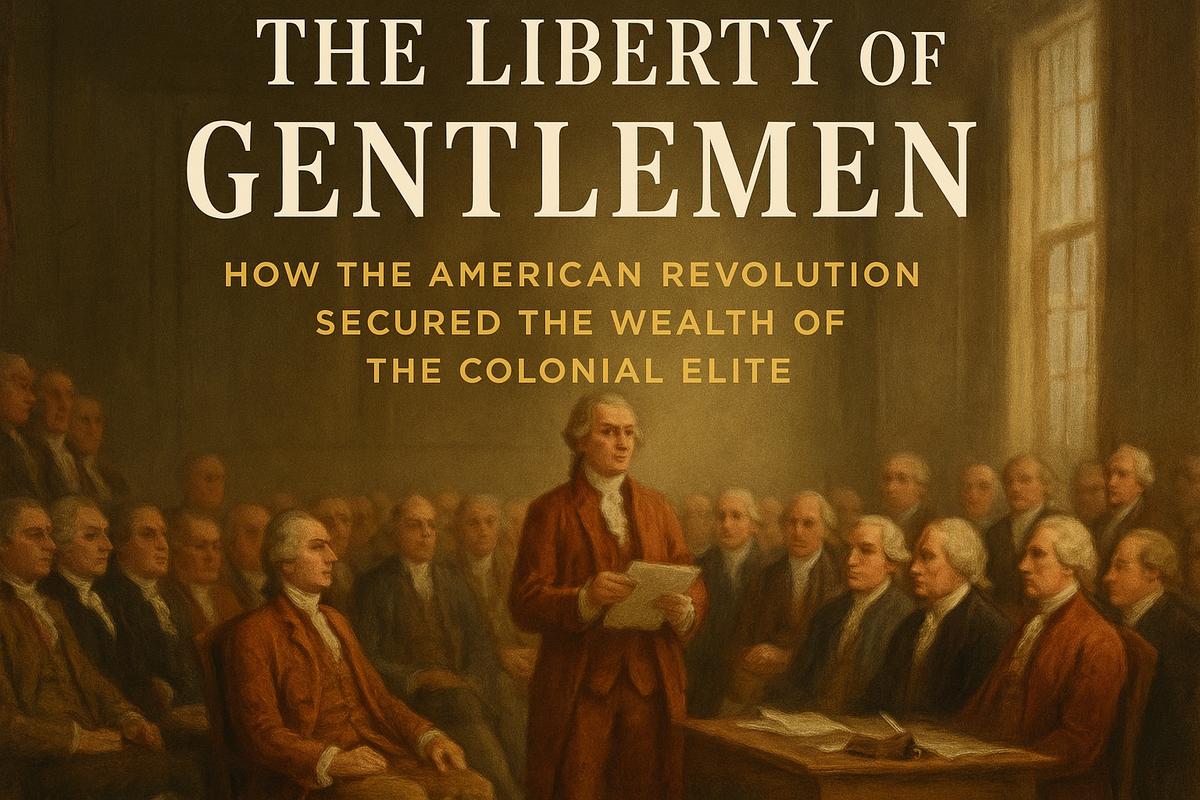The American Revolution is often narrated as a people’s uprising—a spontaneous, righteous rebellion by oppressed colonists who had finally tired of taxation without representation and imperial overreach. But the truth, as always, is more complicated. Beneath the slogans and the muskets, behind the pamphlets and powdered wigs, there was a class of men who understood exactly what was at stake—and how to benefit from it.
These were not artisans, farmers, or radicals. They were the landholding elite: lawyers, merchants, planters, and investors. They had wealth. What they lacked was sovereignty—political control over their own economic destiny. And for many of them, the Revolution was not only a moral crusade. It was a calculated move to break free from the limits imposed by a distant imperial structure that stood in the way of their ambitions.It is easy to forget that the colonies, on the eve of revolution, were not a democratic society. Power was overwhelmingly held by white male property owners, and in many regions—particularly in the South—a small number of families controlled vast tracts of land and labor. These families were, in effect, a local aristocracy, one with strong financial interests in land speculation, westward expansion, and the maintenance of enslaved labor. British policies, especially after the Seven Years’ War, increasingly frustrated those interests. The Proclamation of 1763, which restricted settlement west of the Appalachians, was not perceived as benevolent Native policy by colonial elites—it was seen as a direct obstruction of real estate speculation and wealth accumulation.
Likewise, imperial enforcement of customs duties and taxation—while relatively mild by modern standards—represented an affront to the autonomy of colonial merchants who had grown accustomed to lax enforcement and informal economies. These economic actors didn’t resent government in the abstract; they resented British government specifically, because it demanded taxes, enforced regulations, and restricted their freedom to extract profit from land, labor, and trade.
The revolutionary rhetoric of “liberty” and “natural rights” was not disingenuous, but it was selectively applied. When Jefferson wrote that “all men are created equal,” he did so while owning more than 600 human beings over the course of his life. When Washington called for freedom from British tyranny, he did so as one of the wealthiest men in America, with expansive holdings that depended on enslaved labor and constant expansion into contested frontier territory.
And yet it was precisely these men who defined the Revolution—not the angry mobs in Boston, not the pamphleteers or rebel tailors, but the gentlemen of property and influence. They chaired the Continental Congress. They appointed generals. They negotiated alliances. They wrote the founding documents. When independence came, it did not usher in a new age of equality. It created a government carefully calibrated to preserve the privileges of those who already held power.
The Constitution, when it arrived more than a decade later, made this explicit. The franchise was limited to propertied men. The Senate was designed to insulate the government from popular passion. Slavery was protected through legal ambiguity and structural compromise. The power to regulate commerce and suppress rebellion was written into federal law—tools that would later be used not only against foreign threats but against domestic insurrection by the very laboring classes who had once been rallied in the name of freedom.
This is not to say that the Revolution was illegitimate or purely cynical. Many participants, especially in the lower classes, genuinely believed in the ideals they were fighting for. Enlisted men, tenant farmers, and urban laborers hoped that the overthrow of monarchy would bring an end to economic dependence and political exclusion. But their vision was not the one that prevailed. The Founders spoke of liberty—but it was a liberty designed for landowners.
The irony is sharp. The war that shattered imperial bonds also reinforced local hierarchies. The country that claimed to reject tyranny installed a system in which political power was tethered to property and dissent was often equated with sedition. The revolution did not level society. It clarified who would stand at the top of it.
Even the civil strife described in the previous article—neighbors turned enemies, Loyalists exiled or ruined—served to consolidate power in the hands of the revolutionary elite. The confiscation of Loyalist property enriched many Patriot leaders. Courts, militias, and local governments were stacked with allies. The language of liberty became a kind of currency—a way to legitimize what was ultimately an elite assertion of self-rule.
And what of the marginalized—the enslaved, the indigenous, the propertyless poor? They were offered symbolic inclusion but rarely actual liberation. Their interests were acknowledged in the abstract and sacrificed in practice. The new republic would not be theirs. It would be the property of those who could afford to own it.
This is the hidden architecture of the American Revolution: a class war dressed in the robes of a popular uprising. A political rearrangement that ensured continuity of rule, even as it cast off the king. The colonial gentry did not invent the dream of America, but they defined its borders. They drew its maps, wrote its laws, and made sure that the promises of freedom and equality could be safely confined within the bounds of wealth and race.
In the end, the American Revolution was many things at once: a rebellion, a civil war, a birth, and a betrayal. But above all, it was a success—for those who already stood atop the social pyramid, and who saw in the chaos not a danger, but an opportunity.
om tat sat


Member discussion: